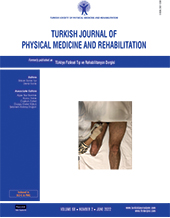The relationship between dietary total antioxidant capacity, clinical parameters, and oxidative stress in fibromyalgia syndrome: A novel point of view
2 University of Health Sciences Türkiye, Gaziler Physical Medicine and Rehabilitation Training and Research Hospital, Ankara, Türkiye
3 Ankara City Hospital, Physical Medicine and Rehabilitation Hospital, Ankara, Türkiye
4 Department of Physical Medicine and Rehabilitation, University of Health Sciences Türkiye, Gülhane School of Medicine, Ankara, Türkiye
5 Department of Nutrition and Dietetics, Hacettepe University, Faculty of Health Sciences,Ankara, Türkiye DOI : 10.5606/tftrd.2022.9741 Objectives: This study aims to reveal the relationship between serum total antioxidant status (TAS), clinical parameters, and nutrition (dietary total antioxidant capacity [TAC]) in patients with fibromyalgia.
Patients and methods: This cross-sectional study was conducted with a total of 60 female participants (mean age: 44.7±9.7 years; range, 18 to 50 years) at Gaziler Physical Medicine and Rehabilitation Hospital between July 2020 and February 2021. Thirty female patients with fibromyalgia were compared with 30 age-, sex-, and body mass index-matched healthy individuals. The short-form McGill Pain Questionnaire, Fibromyalgia Impact Questionnaire (FIQ), and Pittsburg Sleep Quality Index were used. Total antioxidant status, total oxidant status (TOS), and oxidative stress index (OSI) were measured. Dietary TAC was calculated using the ferric reducing ability of plasma according to a food frequency questionnaire.
Results: Total antioxidant status showed no significant difference between groups (p=0.080). Total oxidant status and OSI were significantly higher in the patient group (p<0.001 and p=0.005, respectively). The mean dietary TAC was 16.5±6.5 in the patient group and 17.2±6.2 in the control group, and it was similar between groups (p=0.492). Pittsburg Sleep Quality Index global score was significantly higher in the patient group than in the control group (p<0.001). Dietary TAC showed a moderate positive correlation with serum TAS in both groups (r=0.373, p=0.042 for the patient group, and r=0.380, p=0.038 for the control group). In the patient group, TOS and OSI showed a moderate positive correlation with FIQ total scores (r=0.420, p=0.021 and r=0.450, p=0.013, respectively). The mean polyunsaturated fatty acid and omega-6 intake of the patient group was significantly lower than the control group (p=0.025 for both). Dietary antioxidant intake from vegetables (p=0.025), legumes/nuts (p=0.049), and meat (p<0.001) was significantly lower, whereas dietary antioxidant intake from cereal and potatoes was significantly higher in the patient group compared to the control group (p=0.028).
Conclusion: The results indicate that oxidative stress can be reduced by increasing dietary antioxidant intake in fibromyalgia.
Keywords : Antioxidants, dietary phytochemical index, fibromyalgia, oxidants

















